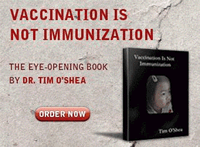 Sayer Ji, Contributing Writer
Sayer Ji, Contributing Writer
Activist Post
It is time to shed some long overdue light on serious and avoidable chemical exposures facing the majority of infants today.
Due to the fact that only 11% of newborns in the US are fed exclusively breast milk during their first six months of life, it is safe to say that most newborns today are exposed to the ingredients found in infant formula.
Owing to the fact that infant formula is being used during the first year of life, which is the most critical developmental period of the human life cycle (outside embryogenesis itself), it behooves us to make sure that what we are feeding them is truly nourishing, and at the very least, not harming them. Correct?
So, what exactly is being put into the infant formulas millions believe is the closest facsimile to human breast milk available?
We will take a more forgiving approach, and avoid the more obviously lower quality mass-market infant formula brands, which use genetically modified products and high fructose corn syrup, to name but a few obvious red flags. Instead, let’s look to a so-called “organic” product, like Earth’s Best Organic Infant Formula, as the assumption here is that it is “Earthy,” “Organic,” and as the label proudly displays: “Produced Without the Use of Potentially Harmful Pesticides.” Did you get that, by the way? “Potentially Harmful Pesticides,” because you know that some pesticides are not actually harmful to infants, right? This strange qualification will take on a clearer, far more chilling meaning in just a moment.
Well, let’s begin our inspection with the “Mineral” ingredients.
- Calcium Chloride — A salt of inorganic calcium and chlorine. Classified as an “Irritant” by the Dangerous Substance Directive (one of the main European Union laws concerning chemical safety), also known as the EU Index. [Material Data Safety Sheet]
- Calcium Hydroxide — also known as “slaked lime,” is classified as “Corrosive” and an “Irritant” by the EU Index, and is used in water and sewage treatment as a “flocculant,” or clarifying agent. [Material Data Safety Sheet]
- Cupric Sulfate — classified as “Harmful,” “Irritant” and “Dangerous to the Environment” by the EU Index. It is used as an herbicide, fungicide and pesticide. [Material Data Safety Sheet]
 Unfortunately, however, given that Cupric Sulfate is commonly used as a pesticide/herbicide, it would be untrue to say the product is “Produced Without the Use of Potentially Harmful Pesticides.”
Unfortunately, however, given that Cupric Sulfate is commonly used as a pesticide/herbicide, it would be untrue to say the product is “Produced Without the Use of Potentially Harmful Pesticides.”
This is, from the perspective of consumer advocacy and truth-in-labeling, highly misleading. We have an entire article titled “Why Is Pesticide Used As An Ingredient In Infant Formula?” on the topic of Cupric Sulfate and formula, if you need a more in-depth analysis on the subject.
So, let’s continue on and see what else the product label has in store for us….
- Ferrous Sulfate: produced as a byproduct of steel production: “In the finishing of steel prior to plating or coating, the steel sheet or rod is passed through pickling baths of sulfuric acid. This treatment produces large quantities of iron(II) sulfate as a by-product.” 1 It is classified by the EU Index as “Harmful” and an “Irritant.” [Material Safety Data Sheet]
- Manganese Sulfate: Classified by the EU Index as “Harmful” and “Dangerous for the environment.” [Material Data Safety Sheet]
- Potassium Bicarbonate: Known to have potentially toxic effects on plants, but generally accepted as safe (GRAS) for human consumption, as determined by the FDA.
- Potassium Chloride: Mostly used to produce fertilizer. It is used in medicine, lethal injections, food processing and as a salt-free substitute for table salt. It has the potential to cause gastrointestinal discomfort, including ulceration when take in supplemental form.
- Potassium Hydroxide: Commonly known as “caustic potash,” and is a strong base, corrosive in nature. It is classified by the EU Index as “Corrosive” and “Harmful.” [Material Safety Data Sheet].
How about “Organic”? Do these “Corrosive,” “Irritant” and “Harmful” ingredients sound like something you would be willing to feed an infant, at any dose? It gets worse.
If we skip forward to Sodium Selenite, we find it is: “Very toxic” and “Dangerous for the environment,” according to the EU Index. In fact, the Material Safety Data Sheet for sodium selenite indicates it has the same toxicity as sodium cyanide at just 7 mg/kg in the rat. At this level of toxicity it would only take 47.5 milligrams to kill a 15 lb infant. For more details on just how toxic sodium selenite and selenate really are, read our article on their toxicity here.
It is an established fact of history that the US FDA approved selenium in the form of selenite and selenate in the early 1970’s, first for use in animal feed and then soon after for human consumption, before their toxicity was fully appreciated. As discussed in one paper:
Unfortunately, not much was known about selenomethionine in the early 1970s, when regulatory agencies had to decide which selenium compounds to allow for use in animal feed. The approval in 1974 of sodium selenite and sodium selenate as feed additives created an unsatisfactory situation. First, the approval suggested that these inorganic selenium salts are nutritional forms of selenium, which they are not. Secondly, the approval diverted attention from selenomethionine, which was soon recognized to be superior to the inorganic selenium salts [14]. However, at the time the regulatory action was taken, only the inorganic selenium salts were available at a cost permitting their use in animal feed.2
Infant formulas, protein mixes and weight loss products still use almost exclusively sodium selenite or sodium selenate. The continuing use of the inorganic selenium compounds is difficult to justify. This is especially true for infant formulas, which through the use of the inorganic selenium salts deprive the growing infant of the benefits which only selenomethionine can provide. Studies with preterm infants [24,25] have already demonstrated that selenium yeast is safe and effective for enteral selenium supplementation. Selenium yeast and selenomethionine were furthermore shown to be superior to selenite in studies with nursing mothers; specifically, more selenium appeared in the milk of mothers obtaining selenium from selenomethionine than from selenite [26].3
 Of course, the problem here is not simply a matter of one form of selenium being “more nutritious” than another, rather, of one being inherently toxic — at any dose — versus one (selenomethione) having very little, if any intrinsic toxicity when used in reasonable dosages.
Of course, the problem here is not simply a matter of one form of selenium being “more nutritious” than another, rather, of one being inherently toxic — at any dose — versus one (selenomethione) having very little, if any intrinsic toxicity when used in reasonable dosages.Infants are all too often looked at as “miniature adults” from the perspective of toxicological risk assessments, rather than what they are: disproportionately (if not exponentially) more susceptible to the adverse effects of environmental exposures. We must demand the reformulation of products that are putting their health at risk, or at the least, refuse to purchase and use them any longer if the companies who produce and market them refuse to reform themselves.
This article first appeared at GreenMedInfo. Please visit to access their vast database of articles and the latest information in natural health.
linkwithin_text=’Related Articles:’




Be the first to comment on "Chemicals As “Nutrients” In “USDA Organic” Infant Formula"